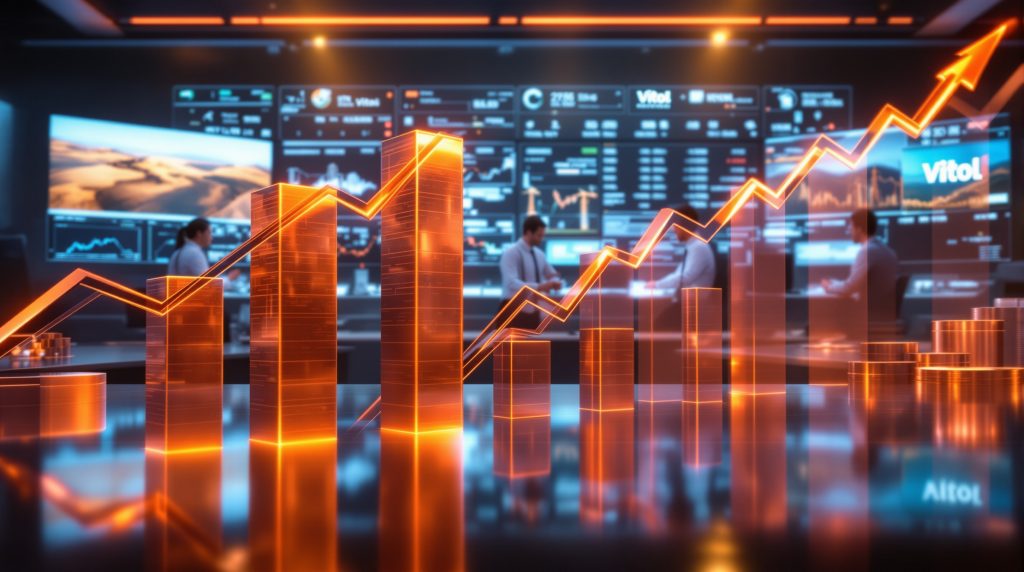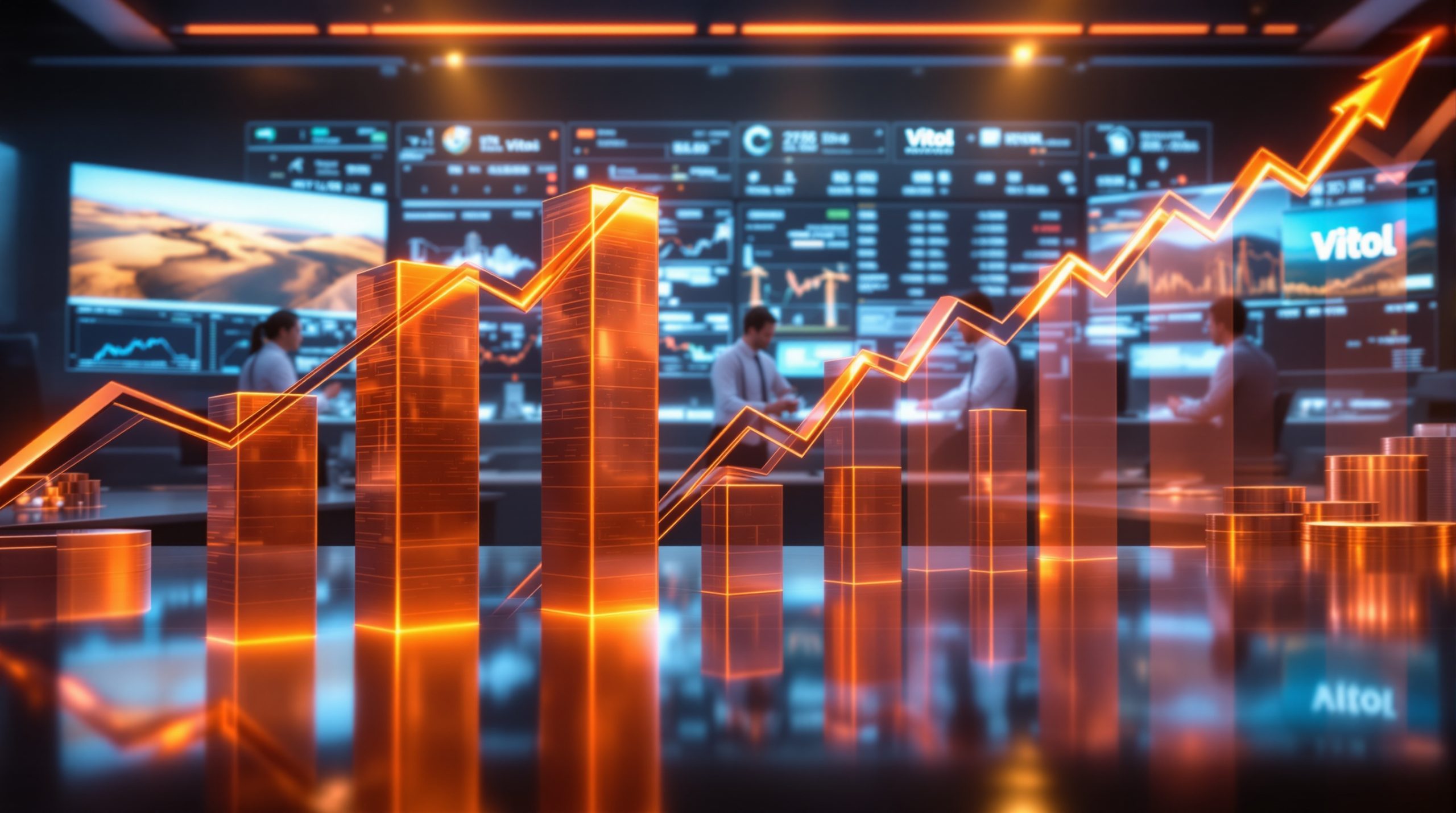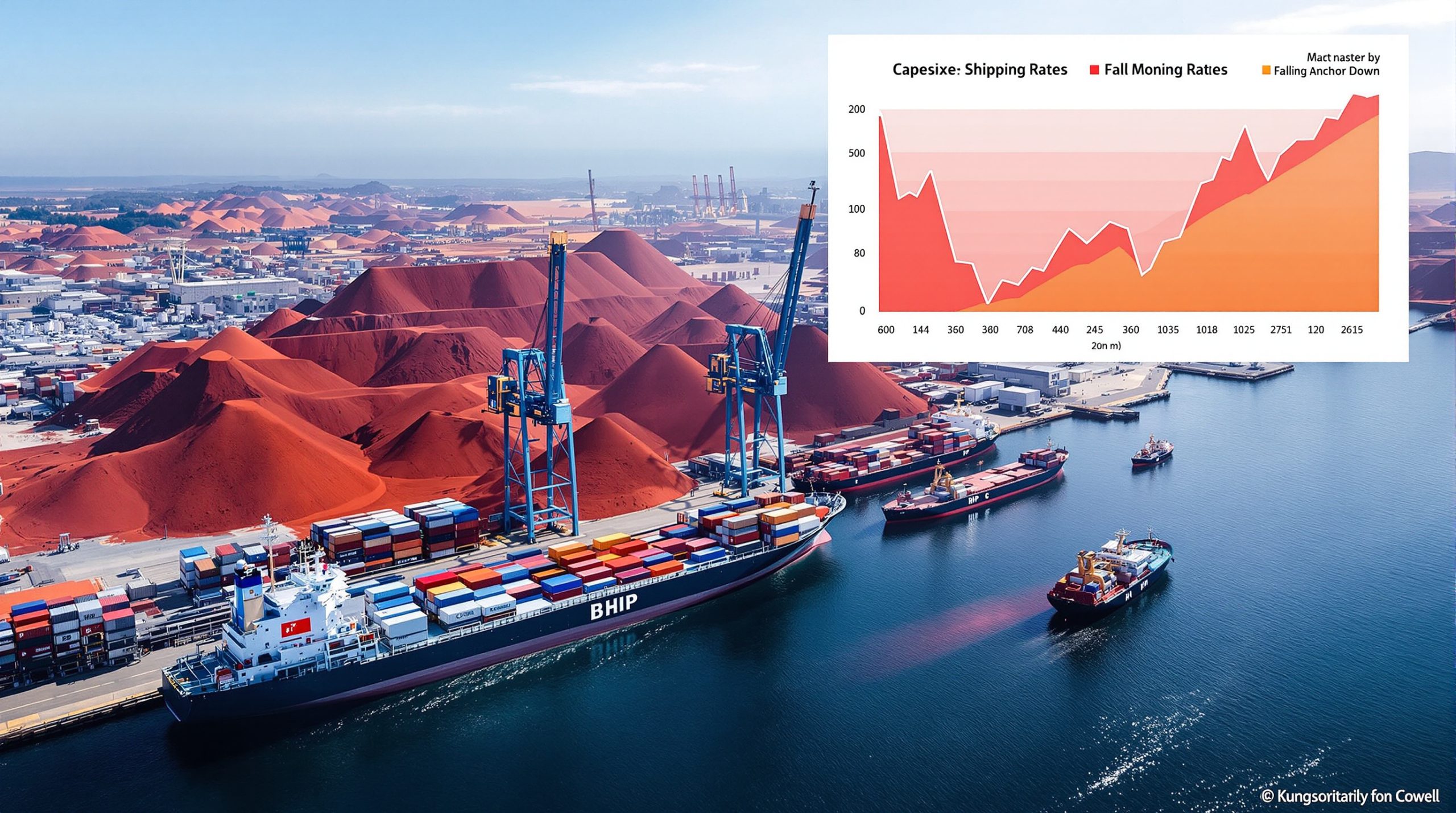Understanding Vitol's Copper Trading Strategy: A Market Analysis
In a strategic move that signals a significant shift in global commodities trading, Vitol has been methodically building its copper trading capabilities throughout 2025. The world's largest independent oil trader has made calculated moves to establish a foothold in the copper market, recognizing the metal's critical importance in the global energy transition. This comprehensive analysis examines Vitol's copper trading strategy, market positioning, and the broader implications for the commodities trading landscape.
How Has Vitol Expanded Its Copper Trading Operations?
Recent Strategic Hires Transform Metals Team
Vitol has systematically strengthened its copper trading team through strategic recruitment of industry veterans. The company appointed Douglas Booth as head of copper concentrates in October 2025, marking the third senior hire in its expanding metals division this year. This followed the recruitment of Bruno Porto as head of copper in March and the addition of Adrien de Sousa as a trader in the refined copper team in June.
These appointments reflect Vitol's commitment to building specialized expertise in copper markets. Booth announced his move on LinkedIn on October 1, joining from IXM in Geneva where he had worked as a senior copper trader since early 2023. His extensive background includes more than 12 years at Glencore as a senior copper trader at the company's headquarters in Switzerland.
Meanwhile, de Sousa joined from SEFE Marketing & Trading, where he had been senior vice president of energy transition metals and minerals in Singapore since October 2024. His diverse experience includes nearly a decade at Mitsubishi Corporation RtM International in Singapore, serving as general manager of the refined metal division and carbon from April 2020 to October 2024, and as lead aluminum trader from March 2015 to March 2020.
Porto, who now leads Vitol's copper division, brings 18 years of experience from Glencore, providing the team with deep market knowledge and established industry relationships.
Building Specialized Expertise Through Selective Recruitment
What distinguishes Vitol's approach is its highly selective recruitment strategy, targeting executives with complementary expertise across different segments of the copper value chain. This team structure enables comprehensive market coverage from concentrate trading to refined products.
Each executive brings specialized knowledge to the table. Booth's experience in copper concentrates trading complements Porto's broad market expertise. Meanwhile, de Sousa contributes valuable perspective from his work across aluminum, carbon, and energy transition trends at Mitsubishi and SEFE.
This diversity of experience creates a multifaceted team capable of identifying opportunities across different market segments and geographies. By recruiting from major competitors including Glencore, IXM, SEFE, and Mitsubishi, Vitol has effectively imported established trading networks and market intelligence.
Why Is Vitol Re-entering The Copper Market Now?
Energy Transition Driving Strategic Diversification
Vitol's copper market re-entry comes at a pivotal moment in the global commodities landscape. In April 2024, CEO Russell Hardy confirmed that the company was rebuilding its metals trading capabilities after a long absence from the market. While describing it as "a relatively small addition to our business," Hardy noted the "exciting decade" ahead for metals markets.
The timing of Vitol's expansion coincides with growing recognition of copper's strategic importance in global electrification efforts. As renewable energy infrastructure expands, electric vehicle adoption accelerates, and power grid modernization continues, copper price predictions suggest significant growth. Industry analysts estimate that meeting climate goals could increase copper demand by 50-70% by 2035, creating lucrative trading opportunities.
Moreover, Vitol is capitalizing on profits earned during the extreme volatility in energy markets following Russia's invasion of Ukraine. This financial strength provides the company with substantial capital to invest in new trading capabilities while competitors might be more constrained.
Learning From Past Experiences
Vitol's approach to copper trading has been shaped by valuable lessons from its previous metals trading ventures. The company traded metals through Euromin in the 1990s but ultimately exited due to challenges with risk management. Hardy acknowledged this history, describing the current effort as "starting from scratch again" but with improved controls and risk management frameworks.
This institutional memory has influenced Vitol's methodical approach to rebuilding its metals trading capabilities. Rather than rushing to capture market share, the company is prioritizing sustainable long-term positioning with robust risk controls. This reflects a sophisticated understanding that metals markets require specialized expertise and risk management approaches distinct from energy trading.
By applying lessons learned from past experiences while leveraging decades of commodities trading expertise, Vitol is positioning itself to avoid previous pitfalls while capitalizing on emerging opportunities in the copper market.
What Makes Vitol's Copper Strategy Different From Competitors?
Cautious Long-Term Approach vs. Aggressive Expansion
Market participants characterize Vitol's copper trading strategy as distinctly measured compared to some competitors. Sources familiar with the company's approach describe it as a "three-to-five year project," indicating a longer-term perspective than peers like Mercuria, which has moved more aggressively into metals markets in 2025.
This patient approach allows Vitol to build capabilities methodically while waiting for optimal market entry points. Rather than immediately pursuing large trading volumes or market share, the company appears focused on establishing the fundamental infrastructure, relationships, and expertise needed for sustainable success in copper markets.
The deliberate pace also reflects Vitol's recognition that metals markets have unique characteristics that differ from its traditional energy trading business. By taking time to understand these nuances, the company can develop tailored trading strategies and risk management approaches specific to copper concentrates and refined copper.
Leveraging Existing Strengths
A key advantage in Vitol's copper strategy is its ability to leverage substantial existing assets. The company's extensive balance sheet capacity, developed through decades of successful energy trading, provides significant financial flexibility when entering copper markets.
Additionally, Vitol can draw upon established global copper supply forecast insights, logistics capabilities, and market intelligence networks that span multiple commodities and regions. This integrated approach allows the company to identify synergies between energy and metals markets that might not be apparent to more specialized traders.
The company is gradually expanding into copper concentrates markets while building capabilities in refined copper trading. This dual-track approach enables Vitol to understand value creation opportunities throughout the copper supply chain rather than focusing on a single segment.
How Does Copper Trading Fit Into Vitol's Broader Commodities Strategy?
Diversification Beyond Traditional Energy Markets
Vitol's expansion into copper represents part of a broader strategic diversification beyond its core oil trading business. In addition to copper, the company has expanded into iron ore markets and aluminum trading in recent years, hiring traders from Glencore and other competitors to build these capabilities.
This diversification serves multiple strategic objectives. First, it positions Vitol to benefit from the energy transition rather than simply managing the risks it poses to traditional fossil fuel markets. Second, it creates natural hedges against certain macroeconomic scenarios, as metals and energy markets often respond differently to economic shifts. Finally, it allows Vitol to deploy its substantial capital across a wider range of opportunities, potentially increasing overall returns.
The expansion also reflects recognition that future commodity markets will increasingly blur traditional boundaries between energy and metals. As electrification accelerates and renewable energy grows, the interconnections between power markets, battery metals, and industrial metals like copper will become more pronounced and create new trading opportunities.
Selective Metal Focus
Rather than pursuing a comprehensive metals trading strategy, Vitol has taken a highly selective approach to which metals it trades. The focus on copper, aluminum, and iron ore reflects a strategic prioritization of metals with significant industrial importance, liquid futures markets, and meaningful market size.
Copper's selection as a priority metal aligns perfectly with long-term global infrastructure and electrification trends. As a critical component in electrical wiring, electric motors, renewable energy systems, and telecommunications, copper sits at the intersection of multiple growth sectors in the global economy.
By concentrating resources on these strategic metals rather than attempting to trade all base metals, Vitol can develop deeper expertise and more meaningful market positions in its chosen segments. This focused approach potentially offers greater long-term value than a broader but shallower metals trading capability.
What Market Conditions Is Vitol Navigating In Copper?
Current Pricing Environment
Vitol is entering copper markets amid specific pricing dynamics that create both challenges and opportunities. As of September 26, 2025, Fastmarkets assessed the copper concentrates TC index for Asia Pacific at $63.40 per tonne, representing a slight decrease of $0.10 from $63.30 per tonne the previous week.
These treatment charges, which represent the mid-point between smelter and trader buying levels, serve as a key indicator of concentrate market conditions. The relatively stable TC levels suggest a market in reasonable balance, though subject to volatility based on mine supply disruptions or smelter maintenance schedules.
The broader copper market has experienced significant price volatility in recent years, driven by supply chain disruptions, shifting demand patterns, and macroeconomic factors. This volatility creates natural trading opportunities for well-capitalized firms like Vitol that can manage price risk effectively while providing liquidity to industrial copper users and producers.
Supply-Demand Dynamics
Several structural factors are reshaping copper supply-demand dynamics, creating a favorable environment for new trading entrants. On the demand side, growth is being driven by:
- Electrification infrastructure: Power grid expansions and upgrades require substantial copper inputs
- Renewable energy systems: Solar and wind installations use 4-5 times more copper than traditional power generation
- Data centers: The AI boom has accelerated data center construction, with each facility requiring significant copper for power systems and connectivity
- Electric vehicles: Each EV uses 2-4 times more copper than conventional vehicles
- Industrial automation: Advanced manufacturing equipment relies heavily on copper components
Meanwhile, supply faces constraints including:
- Mining project delays due to permitting challenges
- Declining ore grades at existing mines
- Water scarcity in key copper-producing regions
- Geopolitical risk in major producing countries
- Limited new discoveries despite increased exploration spending
These dynamics create a market environment where sophisticated trading capabilities can add significant value by managing price risk, optimizing physical flows, and providing financing solutions to producers and consumers.
How Might Vitol's Copper Trading Strategy Evolve?
Potential Future Developments
As Vitol's copper trading capabilities mature, several potential evolutionary paths emerge. The company may expand beyond pure trading into structured financing arrangements with producers, particularly in emerging copper regions facing capital constraints. Such arrangements could secure preferential access to physical supply while generating additional revenue streams.
Another potential development involves specialized trading niches within copper markets. Vitol could develop expertise in specific geographies, grade specifications, or market segments where competition is less intense. This specialization would leverage the company's global reach while creating defensible competitive advantages.
Integration with Vitol's existing energy transition portfolios represents another opportunity. By developing cross-commodity strategies that span power markets, battery metals, and copper, the company could create unique trading propositions that capitalize on the interconnected nature of energy transition commodities.
Risk Management Considerations
As Vitol expands its copper trading activities, risk management will remain paramount. The company is likely implementing copper-specific risk controls and trading parameters distinct from those used in energy markets, reflecting the different volatility patterns, market structures, and liquidity profiles.
Learning from its previous experience in metals markets, Vitol will need to balance opportunistic trading with long-term strategic positioning. This requires sophisticated risk models that account for both short-term price movements and longer-term industry evolution trends affecting copper.
The company must also navigate counterparty risk considerations in copper markets, which involve different players than energy markets. Building relationships with miners, smelters, and industrial consumers requires understanding their unique financial characteristics and business cycles, informing appropriate credit risk management approaches.
What Can Other Market Participants Learn From Vitol's Approach?
Strategic Patience and Expertise Building
Vitol's methodical approach to copper market entry offers valuable lessons for other commodity traders considering new market segments. The company's emphasis on recruiting specialized talent with deep market knowledge before scaling trading activities demonstrates the importance of expertise in new commodity ventures.
The "three-to-five year project" timeframe described by market sources indicates strategic patience rather than pressure for immediate results. This long-term orientation allows for capability building and relationship development that creates sustainable competitive advantages rather than short-term trading profits.
Vitol's leveraging of existing organizational strengths—including balance sheet capacity, risk management expertise, and global reach—while acknowledging the unique characteristics of copper markets shows how successful market entry combines transferable capabilities with commodity-specific knowledge.
Long-Term Vision
Perhaps the most significant lesson from Vitol's copper strategy is its alignment with fundamental, long-term market trends rather than short-term price movements. By recognizing copper's growing importance to the global energy transition and industrial development, the company is positioning for structural growth rather than cyclical trading opportunities.
This long-term vision informs resource allocation, talent recruitment, and risk tolerance decisions. It enables Vitol to weather short-term market volatility while building capabilities that will generate value through multiple market cycles.
For other market participants, this approach highlights the importance of distinguishing between tactical trading opportunities and strategic market positioning. While both have value, sustainable success in commodity markets increasingly requires the latter, particularly as traditional commodity market boundaries blur and new trading patterns emerge. Understanding both bull vs bear perspectives becomes essential for navigating these complex markets.
FAQ: Vitol's Copper Trading Strategy
What is driving Vitol's interest in copper trading?
Vitol recognizes copper's critical role in global electrification, renewable energy infrastructure, and broader energy transition initiatives. The company sees strategic alignment between its traditional energy expertise and the growing importance of metals that enable clean energy technologies. Additionally, copper markets offer attractive trading opportunities for firms with strong balance sheets and sophisticated risk management capabilities.
How does Vitol's approach differ from other trading houses?
Vitol has adopted a more measured, long-term approach compared to competitors like Mercuria. Market sources describe Vitol's strategy as a "three-to-five year project," indicating a focus on sustainable capability building rather than rapid market penetration. This patient approach allows Vitol to develop deep expertise and strong relationships before scaling trading volumes.
What experience do Vitol's new copper trading executives bring?
The company has recruited seasoned professionals with complementary expertise across different segments of the copper value chain. Douglas Booth brings over 12 years of experience from Glencore and IXM, primarily in copper concentrates. Bruno Porto contributes 18 years of experience at Glencore, while Adrien de Sousa adds diversity of perspective from his roles at SEFE and Mitsubishi, where he worked across aluminum, carbon, and energy transition metals.
How significant is copper within Vitol's overall trading portfolio?
While CEO Russell Hardy described the metals trading initiative as "a relatively small addition to our business," the strategic hiring of senior traders indicates a meaningful commitment to building copper trading capabilities over the medium term. Copper represents one component of Vitol's broader diversification into metals markets, which also includes iron ore and aluminum.
What lessons has Vitol applied from its previous metals trading experience?
After exiting metals trading in the 1990s through its Euromin subsidiary due to risk management challenges, Vitol is "starting from scratch again" with improved controls and a more focused approach. The company is applying risk management expertise developed through decades of energy trading while acknowledging the unique characteristics of metals markets that require specialized approaches.
Ready to Spot the Next Big Mineral Discovery on ASX?
Discover how real-time alerts from Discovery Alert's proprietary Discovery IQ model could help you gain a market-leading edge by identifying significant ASX mineral discoveries before the broader market. Visit our discoveries page today to see how historic discoveries have generated substantial returns for informed investors.




